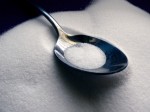 Have you seen the TV ad on sugar? It says the body can’t tell the difference between cane sugar and corn sugar. Well if you were ever going to trust a TV commercial, I would not choose this one.
Have you seen the TV ad on sugar? It says the body can’t tell the difference between cane sugar and corn sugar. Well if you were ever going to trust a TV commercial, I would not choose this one.
Want to know what’s safe and what’s dangerous in the sweetener world? Looking for a natural alternative to satisfy your sweet tooth?
High Fructose corn syrup (HRCS) is made by processing some of its glucose into fructose to produce a desired level of sweetness. But because of its processing, some brands can contain mercury a known neurotoxin. What’s worse, is studies show it suppresses the “full sensation” causing people to over eat. Studies in rats proved this theory.
Fructose comes from the sugar in fruits. .. but it also contains glucose and fiber and other nutrients.
Today, some 70% of packaged foods contain sugar, most of it the HFCS type. According to the Journal of the American Medical Association, sugar and simple carbohydrates like refined grains and HFCS may increase your risk for heart disease and stroke through fat accumulation, metabolic syndrome, obesity, premature aging, and type 2 diabetes. This is nothing new. We’ve all heard that sugar is bad for us.
Here are some better natural choices when it comes to satisfying that sweet taste you love.
Stevia is a South American herb that is estimated to be some 150 to 400 times sweeter than sugar. Coca-Cola is even using it for a few of their low calorie drinks now. We added a little to our Menopause Relief after 100% of our taste testing women loved it with stevia. Sometimes Chinese herbs can be just a little off, but with stevia everybody can drink and enjoy Menopause Relief Herb Pack.
Xylitol and Erythritol: They look like sugar and taste like cane sugar, though some people find that xylitol has a laxative effect. Xylitol was originally isolated from birch sap. Erythritol occurs naturally in fruits and fermented foods.
Inulin: Isolated from Jerusalem artichoke, it is available as a powder or as artichoke syrup. Inulin is a long-chain polysaccharide that is mostly too long a sugar to absorb into the blood stream.
Lo Han Guo: Made from a Chinese herb. It’s a fantastic non-glycemic sweetener It is used in Traditional Chinese Medicine to treat cough and laryngitis and is a common tea in parts of Asia. Because it can be difficult to find and it’s great for my diabetic patients.
Honey (raw, organic) is always the natural sweetener of choice. Look for wild honey because it is lower in free fructose and higher in trace mineral content, especially the richer dark varieties.
Maple syrup: Love it, always have. As a kid I worked harvesting and cooking the sap. It’s the only sustainably-harvested, large-scale, forest sweetener in the world. Maple is one of the richest source of minerals found in any sweetener. Look for organic maple syrup and maple crystals as an ingredient. YUM
Unsulfured, organic sugarcane molasses: It’s rich in vitamins and minerals and has been purported (like fresh sugar cane) to have “anti-stiffness factors” that break down detrimental calcification.
Coconut palm sugar: Now available as a sweetener. It is usually heat-processed, so try to find raw coconut palm sugar.










